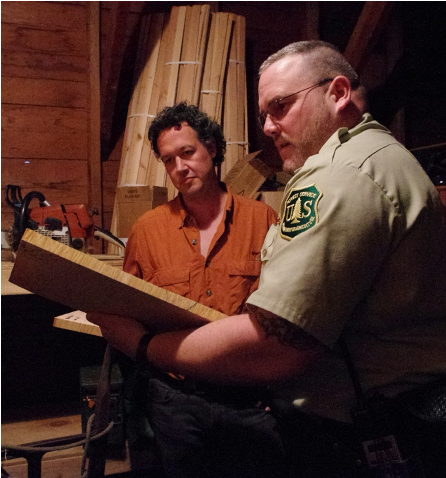Yes of course it makes a noise, but if it is felled illegally can those that perpetrated the crime be caught? Here we delve into the first case to use DNA fingerprinting of trees to match timber back to the site of illegal logging activity, and which led to the prosecution of the perpetrators under the US Lacey Act.
It all started with a phone call one sunny afternoon
‘Hello’
‘Yes, hello – is this Professor Lowe’
‘Speaking’
‘Gee Professor Lowe, its great to speak to you’ <thick American drawl>, ‘this is the US Forestry Service Law Enforcement Division’
‘Wow, how can I help?’
‘Well, I read one of your articles’…
<Thinking quickly, yes I had done an interview for a US trade magazine the year before>
‘…and we have a problem here with illegal logging… we’ve seized some timber from a log yard that we suspect it comes from a group of recently felled trees in a national park – can you do a DNA test for us to prove this?’
‘Well, er, yes’
…and so it began
Turns out there is a big problem with illegal logging in the US, with revenue from such activity estimated at US$1 billion annually.
I’d previously thought that illegal logging was mainly a tropical forest issue, where in some countries it can account for up to 90 % of all traded timber. However its a global issue and one of the world’s largest illicit trades, worth over US$30 billion a year, with few prosecutions.

But as I found out, one of the big targets for illegal logging in North America is the bigleaf maple (Acer macrophyllum Pursch), or tone wood, from the Pacific Northwest. Maple is highly prized for the quality of its grain and translucence patterning when used in string instruments, mainly guitars.
The removal of old growth maple trees from National Parks along the west coast of north America is a significant and increasing problem.
DNA fingerprinting, as originally developed to identify humans and link people to crime scenes, holds tremendous promise to help control illegal logging and can identify species, geographic origin as well as individual trees.
Using these techniques, and supported by the World Resources Institute and Double Helix Tracking Technologies, a map of genetic variation was generated for maple around the Gifford Pinchot National Forest in Washington State, the main crime scene, and extending up to Canada and down to California. The analysis included recently felled stumps in national parks and pieces of timber seized from a local timber yard that was suspected to have been trading in illegally sourced timber.

A total of 394 individuals were DNA fingerprinted using 128 single nucleotide polymorphisms, or independent DNA fingerprinting gene regions. Using these markers the exclusion probability, the chance that two trees shared the same genotype, was calculated as 1.785 × 10 −25. There are only 1021 stars in the universe and only 3 trillion (1012) trees on earth, so the chance that two of these trees shared the same DNA fingerprint is infinitesimally small or almost impossible.
DNA fingerprinting matched several of the pieces of wood seized from the sawmill back to one of the felled stumps in Gifford Pinchot National Forest. This evidence led to four defendants in the case pleading guilty and being sentence to fines and/or jail terms. The prosecutions were made under the Lacey Act, a law specifically designed to stop the illegal trade of wildlife and timber. This was the first time that the Lacey Act had been applied to a case of domestic illegal logging, and the first case in the world where DNA forensics was used to trace the origin of illegally logged timber.
The case has led to a significant rethink across the timber industry in the US, and these methods have since been implemented to control illegal logging across a range of global timber supply chains, and are now recommended by the United Nations Office of Drugs and Crime for controlling and prosecuting cases of illegal logging.

Scientific work featured in article published in:
EE Dormontt, DI Jardine, K-J van Dijk, BF Dunker, RRM Dixon, VD Hipkins, S Tobe, A Linacre, AJ Lowe (2020) Forensic validation of a SNP and INDEL panel for individualisation of timber from bigleaf maple (Acer macrophyllum Pursch). Forensic Science International: Genetics. 46: 102252.
For full text see ResearchGate
and DI Jardine, EE Dormontt, K-J van Dijk, RRM Dixon, B Dunker, AJ Lowe (2015) A set of 204 SNP and INDEL markers for Bigleaf maple (Acer macrophyllum Pursch) Conservation Genetics. 7(4): 797-801.
Feature image zoom in of Metallica album cover And Justice for All





Great article. Amazing the level of accuracy this provides. A great case study for harnessing science to improve traceability and sustainability of our forests.
LikeLiked by 2 people
Thanks Georgina, insightful comments
LikeLiked by 1 person
Thank you Professor Andy for your contribution to keeping the lumber industry honest! I appreciate you using our article on roasted maple for your article. We feel the same and only buy from respected sources with integrity and of excellent reputation. That’s the only way to go!
LikeLike
Thanks for your comment and great to be able to support your work
LikeLike